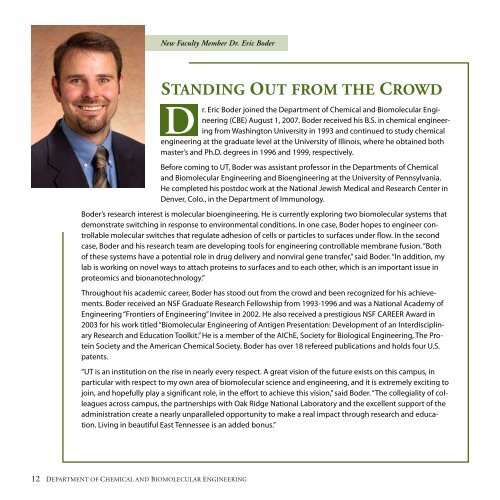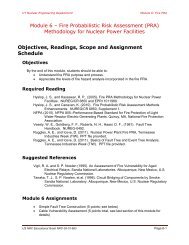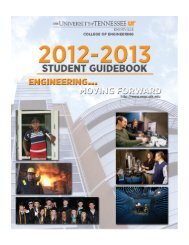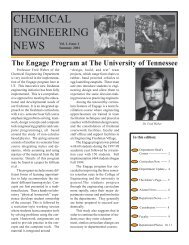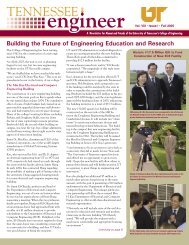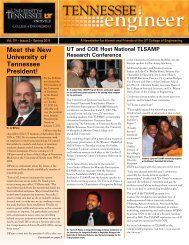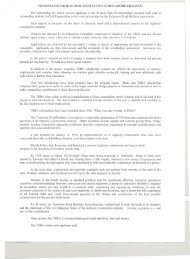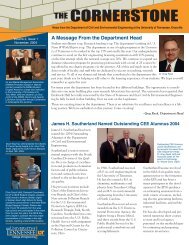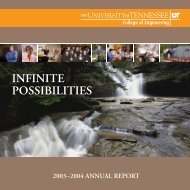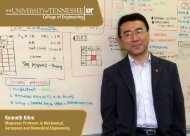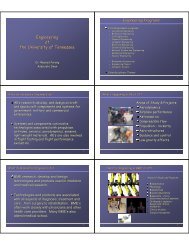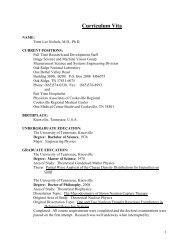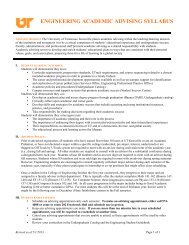CBE 2007 Annual Report - College of Engineering - The University ...
CBE 2007 Annual Report - College of Engineering - The University ...
CBE 2007 Annual Report - College of Engineering - The University ...
You also want an ePaper? Increase the reach of your titles
YUMPU automatically turns print PDFs into web optimized ePapers that Google loves.
New Faculty Member Dr. Eric Boder<br />
STANDING OUT FROM THE CROWD<br />
D<br />
r. Eric Boder joined the Department <strong>of</strong> Chemical and Biomolecular <strong>Engineering</strong><br />
(<strong>CBE</strong>) August 1, <strong>2007</strong>. Boder received his B.S. in chemical engineering<br />
from Washington <strong>University</strong> in 1993 and continued to study chemical<br />
engineering at the graduate level at the <strong>University</strong> <strong>of</strong> Illinois, where he obtained both<br />
master’s and Ph.D. degrees in 1996 and 1999, respectively.<br />
Before coming to UT, Boder was assistant pr<strong>of</strong>essor in the Departments <strong>of</strong> Chemical<br />
and Biomolecular <strong>Engineering</strong> and Bioengineering at the <strong>University</strong> <strong>of</strong> Pennsylvania.<br />
He completed his postdoc work at the National Jewish Medical and Research Center in<br />
Denver, Colo., in the Department <strong>of</strong> Immunology.<br />
Boder’s research interest is molecular bioengineering. He is currently exploring two biomolecular systems that<br />
demonstrate switching in response to environmental conditions. In one case, Boder hopes to engineer controllable<br />
molecular switches that regulate adhesion <strong>of</strong> cells or particles to surfaces under flow. In the second<br />
case, Boder and his research team are developing tools for engineering controllable membrane fusion. “Both<br />
<strong>of</strong> these systems have a potential role in drug delivery and nonviral gene transfer,” said Boder. “In addition, my<br />
lab is working on novel ways to attach proteins to surfaces and to each other, which is an important issue in<br />
proteomics and bionanotechnology.”<br />
Throughout his academic career, Boder has stood out from the crowd and been recognized for his achievements.<br />
Boder received an NSF Graduate Research Fellowship from 1993-1996 and was a National Academy <strong>of</strong><br />
<strong>Engineering</strong> “Frontiers <strong>of</strong> <strong>Engineering</strong>” Invitee in 2002. He also received a prestigious NSF CAREER Award in<br />
2003 for his work titled “Biomolecular <strong>Engineering</strong> <strong>of</strong> Antigen Presentation: Development <strong>of</strong> an Interdisciplinary<br />
Research and Education Toolkit.” He is a member <strong>of</strong> the AIChE, Society for Biological <strong>Engineering</strong>, <strong>The</strong> Protein<br />
Society and the American Chemical Society. Boder has over 18 refereed publications and holds four U.S.<br />
patents.<br />
“UT is an institution on the rise in nearly every respect. A great vision <strong>of</strong> the future exists on this campus, in<br />
particular with respect to my own area <strong>of</strong> biomolecular science and engineering, and it is extremely exciting to<br />
join, and hopefully play a significant role, in the effort to achieve this vision,” said Boder. “<strong>The</strong> collegiality <strong>of</strong> colleagues<br />
across campus, the partnerships with Oak Ridge National Laboratory and the excellent support <strong>of</strong> the<br />
administration create a nearly unparalleled opportunity to make a real impact through research and education.<br />
Living in beautiful East Tennessee is an added bonus.”<br />
AN OPPORTUNITY TO CONTRIBUTE<br />
D<br />
r. Stephen J. Paddison joined the Department <strong>of</strong> Chemical and Biomolecular <strong>Engineering</strong><br />
(<strong>CBE</strong>) August 1, <strong>2007</strong>. Paddison, originally from Canada, comes to UT from the Department <strong>of</strong><br />
Chemistry at the <strong>University</strong> <strong>of</strong> Alabama, Huntsville (UAH), where he was an assistant pr<strong>of</strong>essor<br />
for three and half years.<br />
“I choose <strong>CBE</strong> at UT for the opportunity to join a department with faculty members active in computational<br />
materials science and engineering research,” said Paddison, who received his Ph.D. in physical and theoretical<br />
chemistry from the <strong>University</strong> <strong>of</strong> Calgary in 1996. “My research is both distinct and complimentary to theirs,<br />
and I saw the opportunity in <strong>CBE</strong> to contribute to common and new research thrusts with other members <strong>of</strong><br />
the department and the nearby Oak Ridge National Lab.”<br />
Paddison’s main focus <strong>of</strong> research is the polymer electrolyte membrane (PEM), which is used as the separator<br />
in low temperature proton exchange membrane (PEM) fuel cells. “My research continues to be in the general<br />
area <strong>of</strong> computational materials chemistry,” said Paddison. “Understanding the properties and chemistry <strong>of</strong><br />
materials at the molecular-level entails the application <strong>of</strong> a variety <strong>of</strong> methods including first principles based<br />
and statistical mechanical formulations.”<br />
Paddison was educated as a chemical physicist and has worked in industry and at the Los Alamos National<br />
Laboratory doing reservoir and materials engineering. “My interest in chemical engineering is not new,” said<br />
Paddison. “For the past 11 years, my research has been in the area <strong>of</strong> PEM fuel cells with a specific focus on materials<br />
modeling.”<br />
Paddison was a visiting fellow at Fitzwilliam <strong>College</strong>, <strong>University</strong> <strong>of</strong> Cambridge in the summer <strong>of</strong> 2003 and a<br />
guest scientist at the Max-Planck-Institut für Festkörperforschung during the summer<br />
<strong>of</strong> 2004. He continues collaboration with both institutions in research involving experimental<br />
and computational studies <strong>of</strong> PEM fuel cell materials.<br />
In 2002, Paddison received the Gold Quill Award from Motorola Inc., the mark <strong>of</strong> global<br />
distinction and the highest level <strong>of</strong> pr<strong>of</strong>essional acknowledgement within business<br />
communication today. He also received the UAH Foundation Research & Creative<br />
Achievement Award in <strong>2007</strong>. Paddison holds one patent, has over 50 publications and<br />
is the referee for a dozen different pr<strong>of</strong>essional journals.<br />
Paddison is a member <strong>of</strong> the American Chemical Society, the Electrochemical Society,<br />
<strong>The</strong> Canadian Society <strong>of</strong> Chemical Engineers and the International Society for Solid-<br />
State Ionics.<br />
New Faculty Member Dr. Stephen Paddison<br />
12 DEPARTMENT OF CHEMICAL AND BIOMOLECULAR ENGINEERING <strong>2007</strong> ANNUAL REPORT 13


